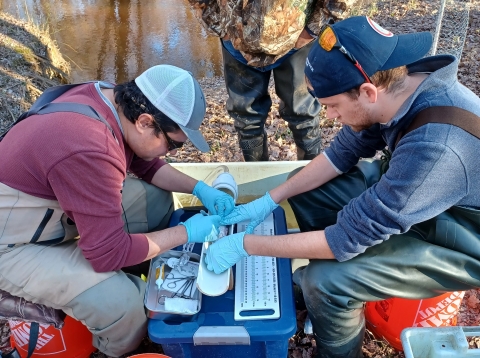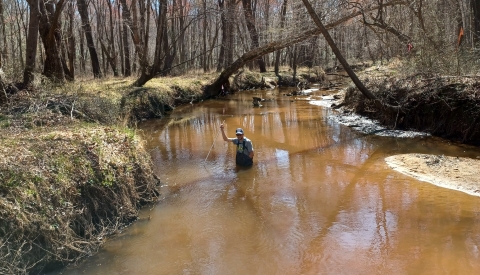For the Rappahannock Tribe of Virginia, river herring and oysters are vital for both ecosystem health and Tribal traditions. Since time immemorial both species have been a food source for Tribal citizens and a connection to nature with the annual river herring run symbolizing a new year for the Tribe. However, as colonists restricted access to Rappahannock Tribal watersheds, Tribal citizens lost connection to these culturally important species and a food source. With the support of a Tribal Wildlife Grant, administered by the U.S. Fish and Wildlife Service’s Office of Conservation Investment, the Rappahannock Tribe is developing a mobile aquaculture unit to raise and release river herring and oysters into the Rappahannock River watershed.
“Through the stocking of native species and the creation of a mobile aquaculture unit, Tribal citizens will benefit from an increased food source that is culturally and physically important,” said Jack Ryan, Director of Environmental and Natural Resource Programs for the Rappahannock Tribe. “The river itself will benefit from the oysters’ filtering the water and increased herring populations will boost the diversity of the river and benefit species that depend on them like striped bass.”
The nearly $200,000 grant, awarded in 2023, has allowed the Rappahannock Tribe to begin conducting genetic research into local herring populations through fin clip sampling. Samples collected from five creeks within the Tribe's ancestral homeland were sent to a fisheries genetic laboratory for analysis. The genetic samples were collected to create a stock structure structure
Something temporarily or permanently constructed, built, or placed; and constructed of natural or manufactured parts including, but not limited to, a building, shed, cabin, porch, bridge, walkway, stair steps, sign, landing, platform, dock, rack, fence, telecommunication device, antennae, fish cleaning table, satellite dish/mount, or well head.
Learn more about structure of the Rappahannock River allowing Ryan’s team to identify distinct stocks that may be geographically separated or have different life history traits. These structures are essential to minimizing genetic risk of stocking operations and are a common tool used in modern fisheries management.
Rappahannock Tribal citizens have used preserved herring as a winter food source for thousands of years, but a collapsed population, private dams, and the complete removal of the Rappahannock Tribe from the Rappahannock watershed have blocked Tribal citizens from connecting with the fishery. Climate change impacts on the remaining 1 percent of historic herring populations has resulted in episodic spawning runs, runs arriving earlier, and runs with less predictability and abundance than in the past. These variables, along with the limited water access to traditional lands have made herring collection almost impossible for Tribal citizens.
Unfortunately, oyster population and access for harvest have also decreased for Tribal citizens. Due to historic overharvest and impacts from shellfish diseases, Chesapeake Bay oyster populations are only a fraction of historic numbers. The Rappahannock Tribe aims to boost oyster numbers by growing hundreds of juvenile oysters in their aquaculture mobile unit for release into nearby waterways. To jumpstart oyster propagation while the mobile aquaculture unit is under construction, the Environmental and Natural Resource Program partnered with nearby Rogue Oyster Company and Friends of Rappahannock to raise the first batch of 210,000 juvenile oysters. It will take 12-18 months for these oyster seed to grow into a suitable size for release into waterways.
“The aquaculture mobile unit supported by this grant is currently being constructed to our specific needs,” adds Ryan. “Once completed, the 8.5 ft x 50 ft trailer that the mobile unit is built on can be parked near waterways to raise river herring and oysters and ultimately release the fish and shellfish into local waterways.” The mobile aquaculture unit is designed to hold a capacity of 4,900 gallons of temperature-controlled water in three 10ft x 5ft tanks. The mobile aquaculture unit was selected over a traditional aquaculture hatchery building to lower construction costs, protect natural resources, and allow access to a water supply without disrupting critical riparian riparian
Definition of riparian habitat or riparian areas.
Learn more about riparian buffer zones. The mobile unit will also allow the Rappahannock Tribe to partner with private landowners along waterways allowing the release of herring and oysters into different stretches of the river and nearby creeks. Once fully operational the mobile aquaculture unit has a goal to raise and release three hundred bushels of oysters and dependent upon the genetic fin sampling research results up to 500,000 river herring fry annually. The released oysters will improve waterway health and diversity by filtering nutrient pollution from the water column while providing habitat for crustaceans and fish. The future release of aquacultured herring fry into certain tributaries could potentially return herring to Rappahannock owned land for the first time in hundreds of years. Ryan hopes this work will provide citizens with food sovereignty and reconnect them to their cultural heritage.
The Service’s Tribal Wildlife Grant funding and grants provided by other agencies are supporting the Rappahannock Tribe’s efforts to build a natural resource program that protects and restores culturally important species. An important part of raising and releasing these culturally important species is the opportunity to connect Tribal citizens to conservation. The project includes multiple opportunities for Tribal citizens to assist with herring sampling and rearing and oyster release and harvest. “Tribal citizens, especially Tribal youth, will have the opportunity to learn how to harvest, preserve, and cook herring and oysters in traditional ways helping to preserve traditional knowledge,” adds Ryan. The Rappahannock Tribe and Ryan’s team will continue to work with a wide array of partners including the Service, the Smithsonian Environmental Research Center, local environmental groups, and landowners to conserve culturally important species and the ecosystem that was successfully stewarded by the Tribe for thousands of years.
Since its inception in 2003, the competitive Tribal Wildlife Grants has provided more than $118 million in funding to federally recognized Native American and Alaska Native Tribes, providing support for culturally and environmentally important species. Tribal Wildlife Grants are vital to supporting capacity building for Tribal natural resource agencies to address species and landscape scale conservation challenges. Learn more about Tribal Wildlife Grants and the species supported through the funding www.fws.gov/service/tribal-wildlife-grants.





